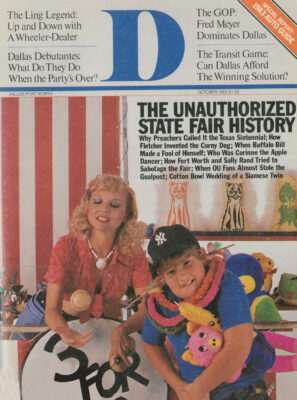IF THERE HAS been a plan of action or a theme employed by the promoters of the state lair musical since its inception in 1925, the strategy has been well concealed. There have been cyclical formulas, including one during the Thirties that was a show-biz bust. But for the most part, the state fair musicals have engendered a remarkable love affair between Broadway and the Texas prairie, serving as the financial proving grounds for a number of truly great roadshows. Here are some of the peaks and crevices during 57 years of life across the street from the Sidney Smith Memorial Fountain, the high notes and the sour notes of the state fair musicals.
The luckiest loss: After spending $500,000 of the taxpayers’ hard-earned money on the State Fair Auditorium, an unusual Spanish-Moorish structure, the promoters were pressed to line up something grand for the premiere engagement. They were horrified when the producers of a hit musical comedy, Sky High, backed out of a handshake agreement. The Schubert brothers, who had already taken over the theater business in New York, had their sights set on the frontier and persuaded Dallas officials to import the latest offering of a popular young Hungarian composer. Sigmund Romberg’s Student Prince grossed $76,000, astounding the local promoters.
The most electrifying moment: Recognizing a winning hand, promoters lined up another Romberg favorite for 1926, a musical version of The Prisoner of Zenda called Princess Flavia. Thrilling the packed house, the great Romberg himself conducted the band on opening night.
The show must go on award: In 1930, Jack Donahue, who was to star in Sons O’ Guns, died on his way to Dallas. With little time to rehearse, Jack Haley took up Donahue’s role, and Dallas had its show.
The most drastic departure from tradition: The auditorium offering in 1934 was called The Show of the Century, a Mike Barnes indoor circus.
The most unusual combination: In a return to the big time in 1946, the fair produced its own show, featuring the unlikely duo of Tommy Dorsey and Gypsy Rose Lee. A near miss in this category was Star Light! Star Bright!, a 1959 revue featuring Rowan and Martin, the McGuire Sisters and Somethin’ Smith and the Redheads.
The biggest gamble: In 1947, auditorium manager Charles Meeker, who had a big league appetite, persuaded state fair president R.L. Thornton to risk a $175,000 guarantee to the producers of Annie Get Your Gun, an amount in excess of gross of any state fair musical in history. Weather-ford’s Mary Martin made a triumphant return to her old stomping grounds and was welcomed by $300,000 worth of cash-paying customers. Never again did a Broadway producer ask whether Dallas had a theater.
The biggest draw: In 1950, South Pacific drew 98,773 spectators and grossed $393,507, the largest box-office sum ever recorded up to that time in American indoor theater for a run of that length. No state fair musical has ever matched SP’s attendance, and it’s doubtful that any ever will, since the seating capacity was reduced from 4,120 to 3,420 during the 1972 renovation. Even the gross record stood until 1974 when it was topped by Debbie Reynolds in Irene, which is remarkable considering the fact that the range in ticket prices for South Pacific was $1.50 to $4.90, cheap by today’s standards.
The most lavish production: Three train car loads of baggage was considered a big show, but in 1957, reporters and camera-men were amazed to discover that the cast of My Fair Lady, starring Brian Aherne as Henry Higgins, had brought five.
The most lovable scoundrel: Forrest Tucker as The Music Man, in 1958.
The critics’ choice: Mary Martin’s great reviews for her performance in Annie Get Your Gun were colored by Martin’s near-hometown appeal and the meager competition that had been offered up to that time. For pure, unbiased rave reviews, the vote goes to Marilyn Michaels as Fanny Brice in Funny Girl in 1965.
The George M. Cohan act-alike contest: Winner: Joel Grey, in the 1969 performance of George M, in which he earned standing ovations in 15 of the 20 performances. Loser: David Cassidy, formerly of television’s Partridge Family, in the 1981 performance of Little Johnny Jones, though he did better than many expected.
Sign of the times award: It cost 11 times as much to renovate the auditorium in 1972 as it did to build it in 1925.
Most nostalgic moment: The 1977 revival of Annie Get Your Gun, starring Debbie Reynolds.
Biggest moneymaker: The 1980 performance of Camelot, which starred an electrifying Richard Burton as King Arthur and had a top ticket price of $22.50, with a gross take of $1,119,517.
The “don’t tell me I can’t go home again” award: Yul Brynner, who is starring in the 1982 production of The King and I. Brynner played the same role in the same production 28 years ago during the 1954 state fair.
Get our weekly recap
Brings new meaning to the phrase Sunday Funday. No spam, ever.
Related Articles

Arts & Entertainment
DIFF Preview: How the Death of Its Subject Caused a Dallas Documentary to Shift Gears
Michael Rowley’s Racing Mister Fahrenheit, about the late Dallas businessman Bobby Haas, will premiere during the eight-day Dallas International Film Festival.
By Todd Jorgenson

Commercial Real Estate
What’s Behind DFW’s Outpatient Building Squeeze?
High costs and high demand have tenants looking in increasingly creative places.
By Will Maddox

Hockey
What We Saw, What It Felt Like: Stars-Golden Knights, Game 2
It's time to start worrying.
By Sean Shapiro and David Castillo


